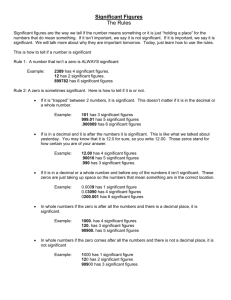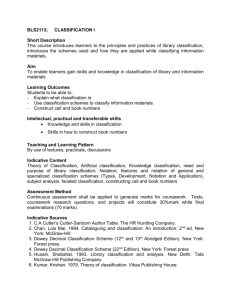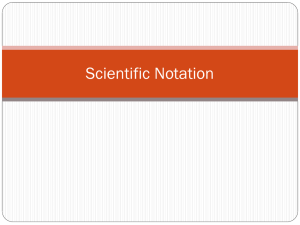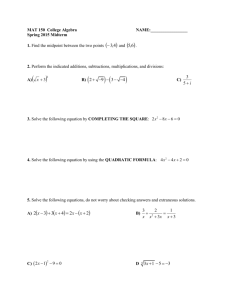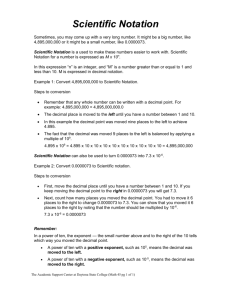National Curriculum Subject: Mathematics Skills Progression: Measure
advertisement
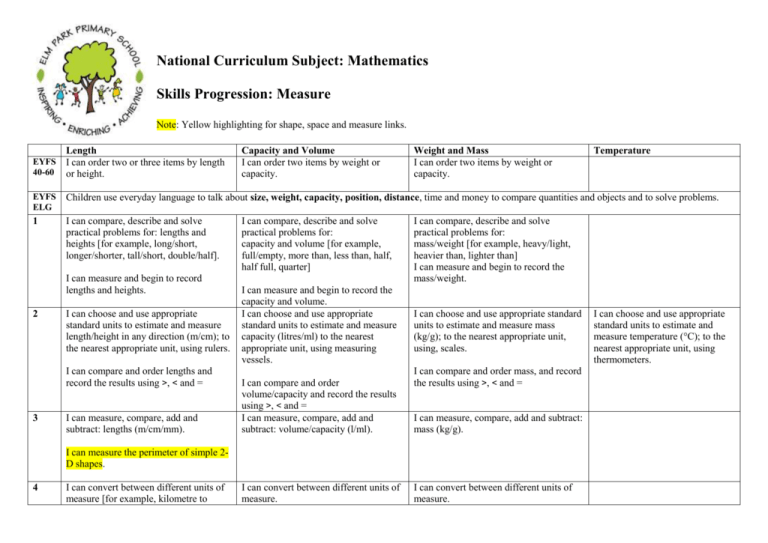
National Curriculum Subject: Mathematics Skills Progression: Measure Note: Yellow highlighting for shape, space and measure links. EYFS 40-60 Length I can order two or three items by length or height. Capacity and Volume I can order two items by weight or capacity. Weight and Mass I can order two items by weight or capacity. Temperature EYFS ELG Children use everyday language to talk about size, weight, capacity, position, distance, time and money to compare quantities and objects and to solve problems. 1 I can compare, describe and solve practical problems for: lengths and heights [for example, long/short, longer/shorter, tall/short, double/half]. I can measure and begin to record lengths and heights. 2 I can choose and use appropriate standard units to estimate and measure length/height in any direction (m/cm); to the nearest appropriate unit, using rulers. I can compare and order lengths and record the results using >, < and = 3 I can measure, compare, add and subtract: lengths (m/cm/mm). I can compare, describe and solve practical problems for: capacity and volume [for example, full/empty, more than, less than, half, half full, quarter] I can measure and begin to record the capacity and volume. I can choose and use appropriate standard units to estimate and measure capacity (litres/ml) to the nearest appropriate unit, using measuring vessels. I can compare and order volume/capacity and record the results using >, < and = I can measure, compare, add and subtract: volume/capacity (l/ml). I can compare, describe and solve practical problems for: mass/weight [for example, heavy/light, heavier than, lighter than] I can measure and begin to record the mass/weight. I can choose and use appropriate standard units to estimate and measure mass (kg/g); to the nearest appropriate unit, using, scales. I can compare and order mass, and record the results using >, < and = I can measure, compare, add and subtract: mass (kg/g). I can measure the perimeter of simple 2D shapes. 4 I can convert between different units of measure [for example, kilometre to I can convert between different units of measure. I can convert between different units of measure. I can choose and use appropriate standard units to estimate and measure temperature (°C); to the nearest appropriate unit, using thermometers. metre] I can estimate, compare and calculate different measures. I can estimate, compare and calculate different measures. I can estimate, compare and calculate different measures. I can convert between different units of metric -measure litre and millilitre. I can convert between different units of metric measure - gram and kilogram. I can understand and use approximate equivalences between metric units and common imperial units e.g. pints. I can understand and use approximate equivalences between metric units and common imperial units such as pounds. I can use all four operations to solve problems involving volume using decimal notation, including scaling. I can use all four operations to solve problems involving mass, using decimal notation, including scaling. I can solve problems involving the calculation and conversion of units of measure, using decimal notation up to I can solve problems involving the calculation and conversion of units of measure, using decimal notation up to I can measure and calculate the perimeter of a rectilinear figure (including squares) in centimetres and metres. 5 I can find the area of rectilinear shapes by counting squares. I can convert between different units of metric measure - kilometre and metre; centimetre and metre; centimetre and millimeter. I can understand and use approximate equivalences between metric units and common imperial units such as inches. I can measure and calculate the perimeter of composite rectilinear shapes in centimetres and metres. I can estimate volume [for example, using 1 cm3 blocks to build cuboids I can calculate and compare the area of (including cubes)] and capacity [for rectangles (including squares), and example, using water] including using standard units, square centimetres (cm2) and square metres (m2) and estimate the area of irregular shapes. 6 I can use all four operations to solve problems involving measure/length using decimal notation, including scaling. I can solve problems involving the calculation and conversion of units of measure, using decimal notation up to three decimal places where appropriate. three decimal places where appropriate. three decimal places where appropriate. I can use, read, write and convert between standard units, converting measurements of length from a smaller unit of measure to a larger unit, and vice versa, using decimal notation to up to three decimal places. I can use, read, write and convert between standard units, converting measurements of volume from a smaller unit of measure to a larger unit, and vice versa, using decimal notation to up to three decimal places. I can use, read, write and convert between standard units, converting measurements of mass, from a smaller unit of measure to a larger unit, and vice versa, using decimal notation to up to three decimal places. I can recognise that shapes with the same areas can have different perimeters and vice versa. I can recognise when it is possible to use formulae for volume of shapes. I can recognise when it is possible to use formulae for area. I can calculate the area of parallelograms and triangles. I can convert miles to kilometres. I can calculate, estimate and compare volume of cubes and cuboids using standard units, including cubic centimetres (cm3) and cubic metres (m3), and extending to other units [for example, mm3 and km3].

